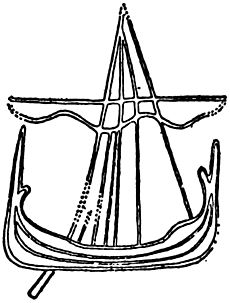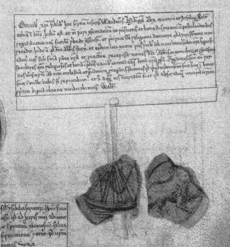Rǫgnvaldr Óláfsson (died 1249) facts for kids
Quick facts for kids Rǫgnvaldr Óláfsson |
|
|---|---|

Rǫgnvaldr Óláfsson's name as it appears on folio 47r of British Library Cotton Julius A VII (the Chronicle of Mann): "Reginaldus Olavi filius".
|
|
| King of Mann and the Isles | |
| Reign | 6 May 1249 – 30 May 1249 |
| Predecessor | Haraldr Óláfsson |
| Successor | Haraldr Guðrøðarson |
| Died | 30 May 1249 |
| Burial | Rushen Abbey |
| House | Crovan dynasty |
| Father | Óláfr Guðrøðarson |
| Mother | Cairistíona inghean Fearchair |
Rǫgnvaldr Óláfsson (died 30 May 1249) was a king who ruled the Kingdom of the Isles for a very short time in the mid-1200s. He was killed after being king for less than a month. Rǫgnvaldr was part of the powerful Crovan dynasty, a family that ruled the Isles.
His father, Óláfr Guðrøðarson, was also a king. When Óláfr died in 1237, Rǫgnvaldr's brother, Haraldr Óláfsson, became king. Haraldr was lost at sea in late 1248. The next year, Rǫgnvaldr Óláfsson took his place as king.
Just weeks after becoming king, Rǫgnvaldr Óláfsson was attacked and killed. A knight named Ívarr and his helpers were responsible. After Rǫgnvaldr's death, his cousin, Haraldr Guðrøðarson, quickly took over as king. This suggests that the killers and the new king might have worked together. Rǫgnvaldr's death seemed to be part of a long and difficult family fight. This feud had been going on in the Crovan dynasty since the late 1100s.
Contents
Who was Rǫgnvaldr Óláfsson?

Rǫgnvaldr Óláfsson was one of several sons of Óláfr Guðrøðarson, who was King of Mann and the Isles. This made Rǫgnvaldr a member of the Crovan dynasty. This was a very important family. They ruled the Kingdom of the Isles from the late 1000s to the mid-1200s.
The Kingdom of the Isles was known as Suðreyjar in Old Norse. This means "Southern Islands." It included the Hebrides and the Isle of Man. Historical records show that the kings of the Isles usually accepted the authority of the kings of Norway.
Family Feuds
From the late 1100s to the mid-1200s, the Crovan dynasty faced many bitter family fights. Rǫgnvaldr Óláfsson's father, Óláfr, was a younger son of Guðrøðr Óláfsson, King of Dublin and the Isles. Before he died in 1187, Guðrøðr Óláfsson wanted Óláfr to become king. However, Óláfr was just a child at the time. So, the people of the Isles chose Rǫgnvaldr Guðrøðarson as king instead. He was Guðrøðr Óláfsson's oldest son, but not his legal heir.
As the 1200s began, the two half-brothers, Óláfr and Rǫgnvaldr Guðrøðarson, started a full-blown war. Óláfr eventually married Cairistíona, the daughter of Fearchar mac an tSagairt, Earl of Ross. This marriage helped Óláfr gain military support from Cairistíona's father. The fierce conflict between the half-brothers ended when Rǫgnvaldr Guðrøðarson was killed in 1229. After that, Óláfr ruled the entire kingdom without major challenges until he died in 1237.
The Chronicle of Mann
The main historical book about the Crovan dynasty kings is the Chronicle of Mann. It is the only local record from that time about these rulers. The book we have today is a copy from the 1300s. It was likely first written during the reign of Magnús Óláfsson, King of Mann and the Isles.
About 15% of the chronicle talks about the fight between the half-brothers. Much of the rest discusses what happened after this conflict. The chronicle seems fair when describing the half-brothers' struggle. However, it clearly favors Óláfr's sons when talking about their descendants. In fact, Óláfr's sons only fully defeated Rǫgnvaldr Guðrøðarson's family during the reign of Óláfr's son, Magnús. Because of this, the chronicle might have been written to make Óláfr's sons seem more rightful kings. Even its claim that Óláfr's father chose him as successor might not be completely true.
| Simplified family tree of the Crovan dynasty, showing how Rǫgnvaldr was related to others in his family. | ||||||||||||||||||||||||||||||||||||||||||||||||||||||||||||||||||||||||||||||||||||||||||||||||||||||||||||||||||||||||||||||||||||||||||||||||||||||||||||||||||||||||||||||||||||||||||||||||||||||||||||||||||||||||||||||||||||||
|---|---|---|---|---|---|---|---|---|---|---|---|---|---|---|---|---|---|---|---|---|---|---|---|---|---|---|---|---|---|---|---|---|---|---|---|---|---|---|---|---|---|---|---|---|---|---|---|---|---|---|---|---|---|---|---|---|---|---|---|---|---|---|---|---|---|---|---|---|---|---|---|---|---|---|---|---|---|---|---|---|---|---|---|---|---|---|---|---|---|---|---|---|---|---|---|---|---|---|---|---|---|---|---|---|---|---|---|---|---|---|---|---|---|---|---|---|---|---|---|---|---|---|---|---|---|---|---|---|---|---|---|---|---|---|---|---|---|---|---|---|---|---|---|---|---|---|---|---|---|---|---|---|---|---|---|---|---|---|---|---|---|---|---|---|---|---|---|---|---|---|---|---|---|---|---|---|---|---|---|---|---|---|---|---|---|---|---|---|---|---|---|---|---|---|---|---|---|---|---|---|---|---|---|---|---|---|---|---|---|---|---|---|---|---|---|---|---|---|---|---|---|---|---|---|---|---|---|---|---|---|
|
||||||||||||||||||||||||||||||||||||||||||||||||||||||||||||||||||||||||||||||||||||||||||||||||||||||||||||||||||||||||||||||||||||||||||||||||||||||||||||||||||||||||||||||||||||||||||||||||||||||||||||||||||||||||||||||||||||||
Rǫgnvaldr Becomes King and is Killed

After Rǫgnvaldr's father died, his brother Haraldr Óláfsson became king. But the Chronicle of Mann says that Haraldr was soon removed from power. This was done by people sent by Hákon Hákonarson, King of Norway. Haraldr tried to fight them off but failed. He then sailed to Norway and stayed there for about three years. He made peace with King Hákon, who then helped him become king of the Isles again.
In 1247, another historical book, Hákonar saga Hákonarsonar, says that Haraldr Óláfsson went to Norway again. He married Hákon's daughter, Cecilía, in the winter of 1247-1248. In the autumn of 1248, as the newly married couple sailed back, their ship sank near Shetland. Both the chronicle and the saga report that everyone on board was lost.
When King Hákon heard about this terrible event, he quickly sent Eóghan Mac Dubhghaill to temporarily rule the Isles for him. According to the Chronicle of Mann, Rǫgnvaldr Óláfsson became King of the Isles on May 6, 1249. It's possible that he and Eóghan shared some power in the Isles.
A Very Short Reign
Rǫgnvaldr Óláfsson's time as king was extremely short. It lasted for less than a month. The chronicle states that he was killed on May 30, 1249. Rǫgnvaldr Óláfsson's body was buried at Rushen Abbey. This was the same place where his father was buried. After the killing, the chronicle says that Haraldr Guðrøðarson took over as king. Haraldr was the grandson of Rǫgnvaldr Guðrøðarson, the half-brother who had fought with Rǫgnvaldr Óláfsson's father.
The chronicle names Rǫgnvaldr Óláfsson's killers as a knight named Ívarr and his followers. We are not completely sure who this Ívarr was. There was an uncle of Rǫgnvaldr Óláfsson named Ívarr Guðrøðarson. However, he would have been very old in 1249, so it's unlikely to be him. The chronicle calls the killer a "knight," which means he was likely an important person. But the fact that he doesn't have a family name suggests he wasn't from a famous family like the Crovan dynasty. He might be the "Lord Ívarr of Mann" who signed a document for Haraldr Óláfsson in 1246.
The timing of events around Rǫgnvaldr Óláfsson's killing suggests that Haraldr Guðrøðarson and Ívarr were working together. A letter from Henry III, King of England, written in April 1256, further supports this. The letter tells his men not to help Haraldr Guðrøðarson and Ívarr. It says these men "wickedly slew" Rǫgnvaldr Óláfsson.
The End of a Feud
Because Ívarr might have worked with Haraldr Guðrøðarson, Rǫgnvaldr Óláfsson's killing shows that the family feud continued. This fight was between the two branches of the family, those descended from Rǫgnvaldr Guðrøðarson and those from Óláfr. This conflict lasted well into the mid-1200s. In fact, this killing is the last recorded time a king was murdered in the Norse-Gaelic kingdom.
Rǫgnvaldr Óláfsson's successor, Haraldr Guðrøðarson, also had a very short reign. He was called back to Norway in 1250 because he had taken the kingship unfairly. Once in Norway, he was not allowed to return to the Isles and is not heard from again. Within two years, Rǫgnvaldr Óláfsson's brother, Magnús, became king. Magnús ruled until he died in 1265. He was the last member of the Crovan dynasty to rule as king in the Isles.
The long family wars within the Crovan dynasty sometimes caused the kingdom to be split between different groups. For example, from about 1187 to 1226, and briefly in 1229, the kingdom was divided between the half-brothers. For a short time in 1230-1231, it was divided between Óláfr and his nephew, Guðrøðr Dond. While Haraldr Óláfsson seemed to rule a united kingdom, the years between his death and Magnús becoming king in 1252 are unclear. It's possible the kingdom was divided during this short period. Rǫgnvaldr Óláfsson had at least one daughter, Maria. In 1305, a grandson of Maria tried to claim the Isle of Man.
Ancestry
| Ancestors of Rǫgnvaldr Óláfsson (died 1249) | |||||||||||||||||||||||||||||||||||||||||||||||||||||||||||||||||||||||||||||||||||||||||||||||||||||||||||||||||||||||||||||||||||||||||||||||||||||||||||||||||||||||||||||||||||||||||||||||||||||||||||||||||||||||||||||||||||||||||||||||||||||||||||||||||||||||||||||||||||||||||||||||||||||||||||||||||||||||||||||||||||||||||||||||||||||||||||||||||||||||||||||||||||||||||||||||||||||||||||||||||||||||||||||||||||||||||||||||||||||||||||||||||||||||||||||||||||
|---|---|---|---|---|---|---|---|---|---|---|---|---|---|---|---|---|---|---|---|---|---|---|---|---|---|---|---|---|---|---|---|---|---|---|---|---|---|---|---|---|---|---|---|---|---|---|---|---|---|---|---|---|---|---|---|---|---|---|---|---|---|---|---|---|---|---|---|---|---|---|---|---|---|---|---|---|---|---|---|---|---|---|---|---|---|---|---|---|---|---|---|---|---|---|---|---|---|---|---|---|---|---|---|---|---|---|---|---|---|---|---|---|---|---|---|---|---|---|---|---|---|---|---|---|---|---|---|---|---|---|---|---|---|---|---|---|---|---|---|---|---|---|---|---|---|---|---|---|---|---|---|---|---|---|---|---|---|---|---|---|---|---|---|---|---|---|---|---|---|---|---|---|---|---|---|---|---|---|---|---|---|---|---|---|---|---|---|---|---|---|---|---|---|---|---|---|---|---|---|---|---|---|---|---|---|---|---|---|---|---|---|---|---|---|---|---|---|---|---|---|---|---|---|---|---|---|---|---|---|---|---|---|---|---|---|---|---|---|---|---|---|---|---|---|---|---|---|---|---|---|---|---|---|---|---|---|---|---|---|---|---|---|---|---|---|---|---|---|---|---|---|---|---|---|---|---|---|---|---|---|---|---|---|---|---|---|---|---|---|---|---|---|---|---|---|---|---|---|---|---|---|---|---|---|---|---|---|---|---|---|---|---|---|---|---|---|---|---|---|---|---|---|---|---|---|---|---|---|---|---|---|---|---|---|---|---|---|---|---|---|---|---|---|---|---|---|---|---|---|---|---|---|---|---|---|---|---|---|---|---|---|---|---|---|---|---|---|---|---|---|---|---|---|---|---|---|---|---|---|---|---|---|---|---|---|---|---|---|---|---|---|---|---|---|---|---|---|---|---|---|---|---|---|---|---|---|---|---|---|---|---|---|---|---|---|---|---|---|---|---|---|---|---|---|---|---|---|---|---|---|---|---|---|---|---|---|---|---|---|---|---|---|---|---|---|---|---|---|---|---|---|---|---|---|---|---|---|---|---|---|---|---|---|---|---|---|---|
|
|||||||||||||||||||||||||||||||||||||||||||||||||||||||||||||||||||||||||||||||||||||||||||||||||||||||||||||||||||||||||||||||||||||||||||||||||||||||||||||||||||||||||||||||||||||||||||||||||||||||||||||||||||||||||||||||||||||||||||||||||||||||||||||||||||||||||||||||||||||||||||||||||||||||||||||||||||||||||||||||||||||||||||||||||||||||||||||||||||||||||||||||||||||||||||||||||||||||||||||||||||||||||||||||||||||||||||||||||||||||||||||||||||||||||||||||||||

